It’s an alarming statistic – in less than 5 years, over 40% of the nation’s 1,200 community college presidents are projected to retire, leaving critical openings at a time when demands have drastically increased. Who will lead our community colleges in the years to come so they can successfully educate an increasingly diverse, often under-prepared student population?
Faced with this looming leadership void, we joined forces with Achieving the Dream – one of the nation’s leading community college reform organizations– to tackle this crisis. On Friday, June 21st, we released our joint report, Crisis and Opportunity: Aligning the Community College Presidency with Student Success, which assesses the challenge and recommends steps needed to ensure that our nation’s hiring and professional development practices deliver exceptional community college presidents. While some good work is being done in the field, we need to urgently address the inadequacies in the current leadership pipeline and prepare for the upcoming demand.
This is a time of unusually high turnover in the community college sector. Over 140 have taken office in the last year alone, according to the American Association of Community Colleges. And there’s every indication that this trend will accelerate. But equally important is the changing environment. If the past five to ten years is any indication, what presidents will face in the coming decade is rapid, fundamental change in the context within which they deliver education. While community colleges are being called on to improve graduation rates and better align their programs with labor market needs, states and families have less money to spend on education, online competition is growing and most students continue to arrive underprepared.
But the most profound change is in expectations and accountability. Simply put, the primary benchmark of excellence at community colleges is no longer access alone – it is centered on student success in the classroom and in the job market after graduating. By those standards, well under half of students succeed today. Community colleges need to produce more degrees of a higher quality at a lower per-student cost to an increasingly diverse population. And that requires a new vision for leadership. Whether a community college can navigate all of these changes effectively and improve student success will depend substantially on who the president is and what the president does.
Our report cites major gaps in the way community college presidents are currently being recruited, prepared for the job, and evaluated, and offers suggestions about what needs to happen next.
On education and professional development front, we need:
- New courses and programs that prepare future presidents to lead internal organizational change that results in new ways of delivering education that enable students to succeed at much higher rates.
- Programs that teach core skills such as budgeting, fundraising and advocacy in ways that are aligned to the central goal of improving student success, not just keeping institutions afloat
- Re-envisioned ways to educate help presidents on developing strong partnerships with external organizations – from employers to K-12 schools to four-year colleges – that deliver strong pathways to completing college with job-ready skills
On the hiring front, trustees and other hiring authorities need to:
- Look for proof of a candidate’s deep commitment to student success
- Consider hiring leaders who will take necessary risks and have the ability to foster internal change on college campuses
- Consider non-traditional candidates from outside academia
It is time to translate what we know into action, to put much more effort into finding and grooming the next generation of leaders, to raise the bar for all those involved in the process of hiring and professional development, and to ensure that we have the kind of leadership needed to ensure that every community college can dramatically improve student success. The stakes are enormous for millions of learners who we all need to be the bedrock of America’s middle class going forward.

